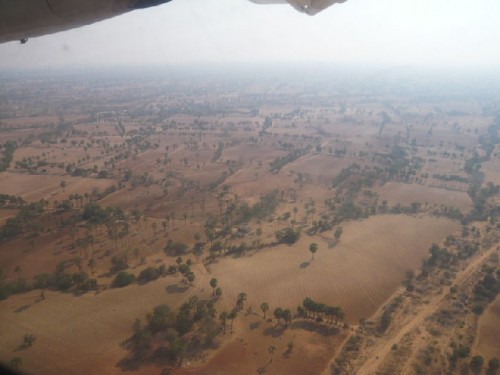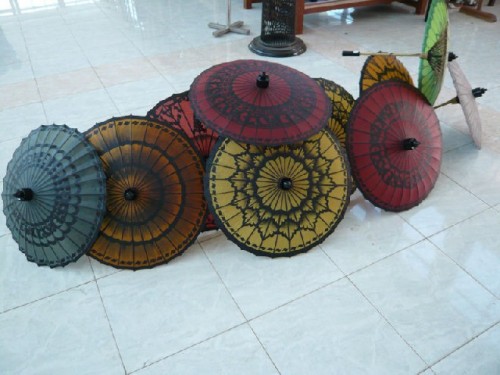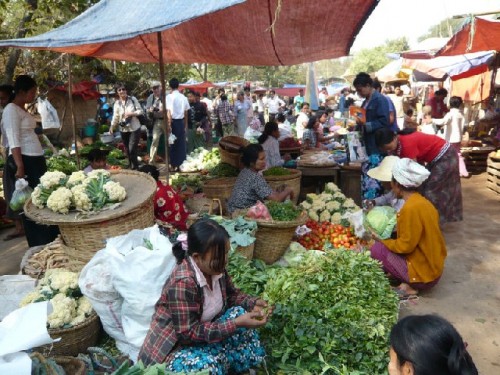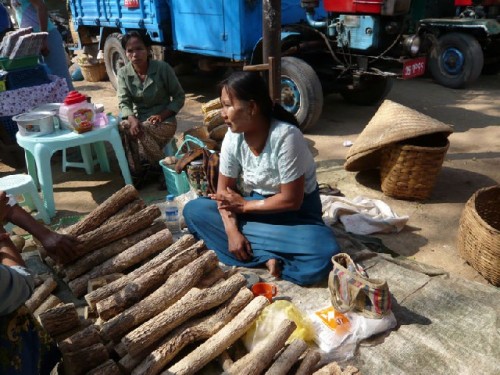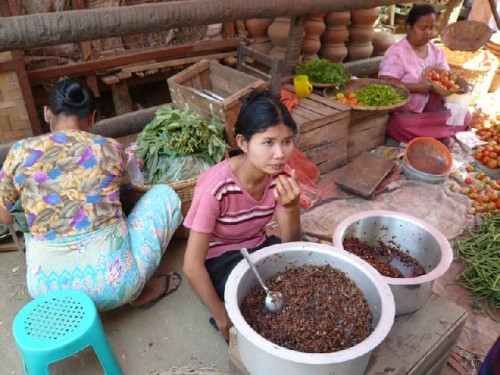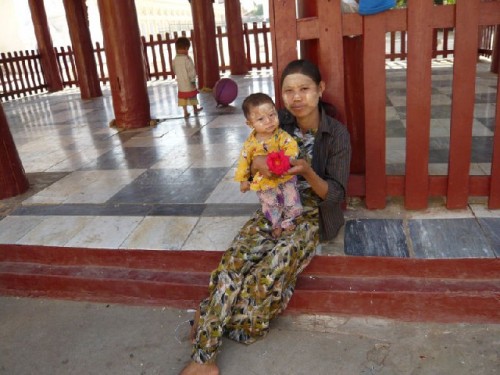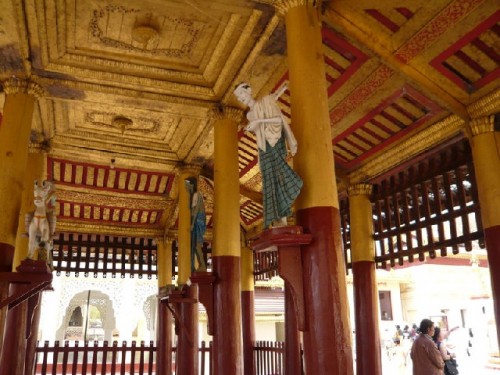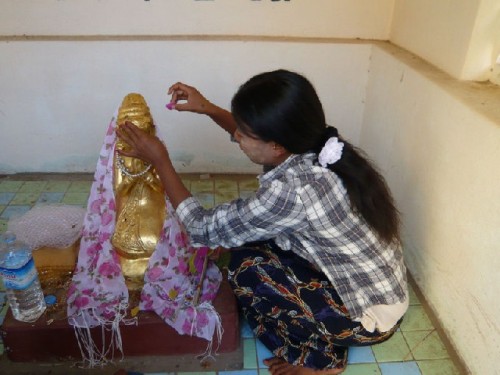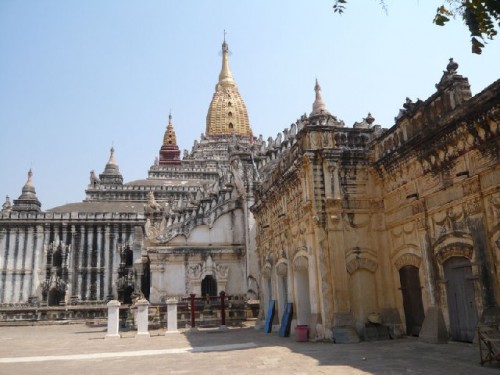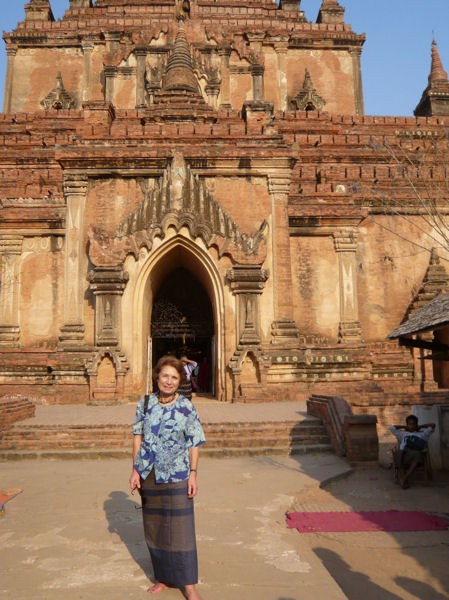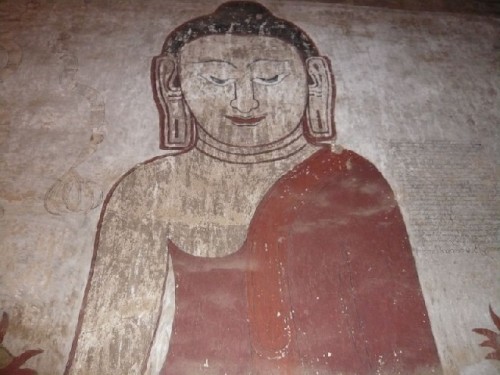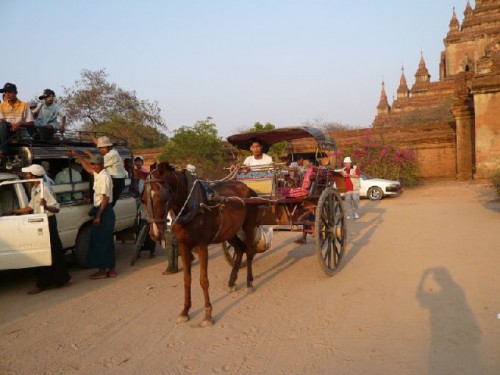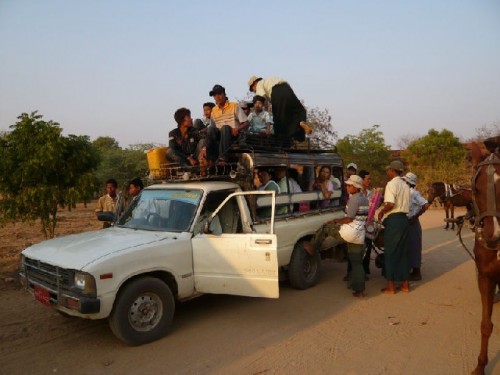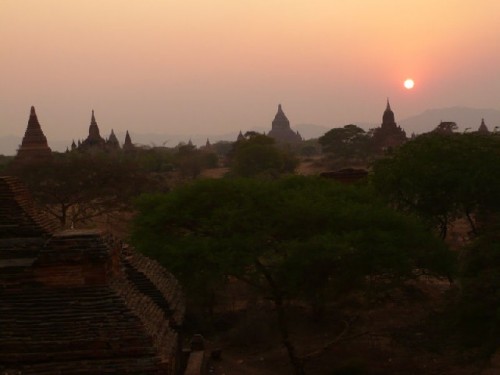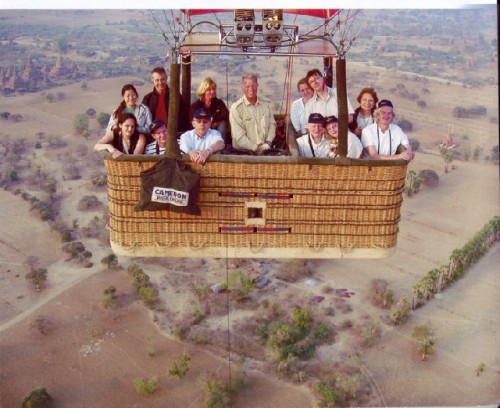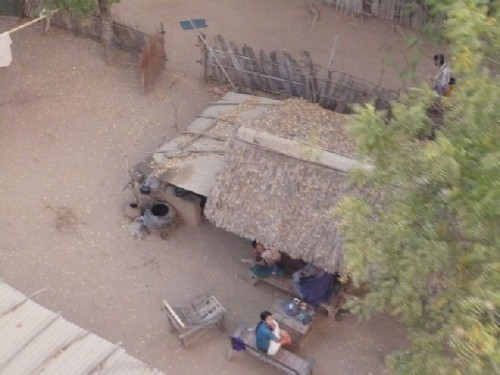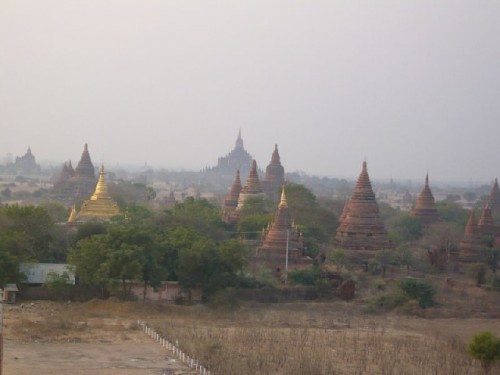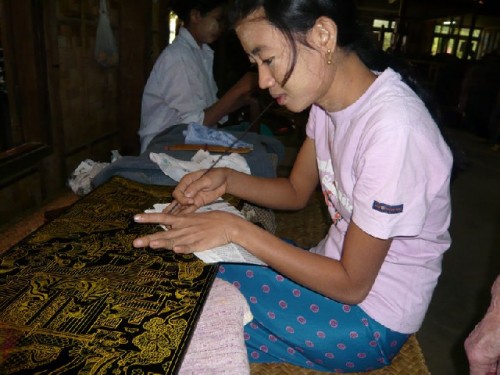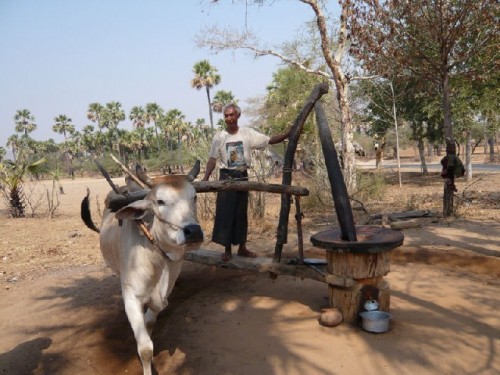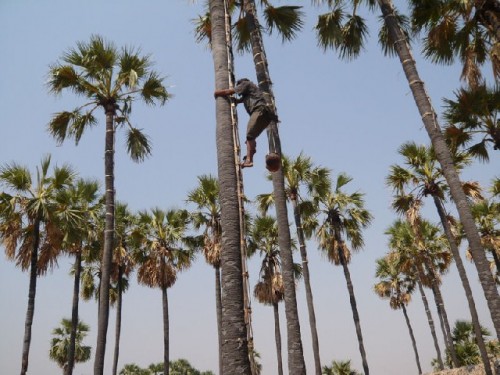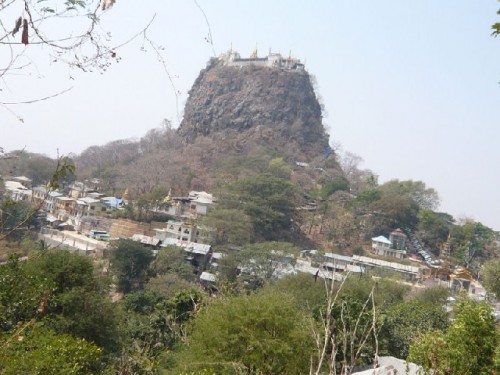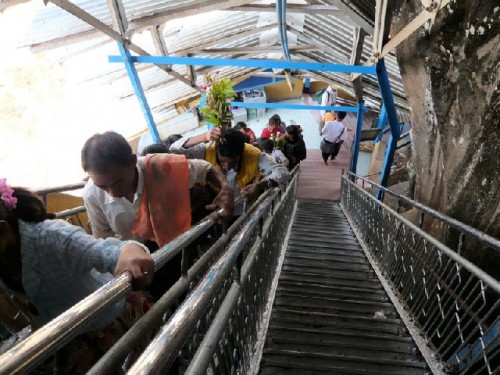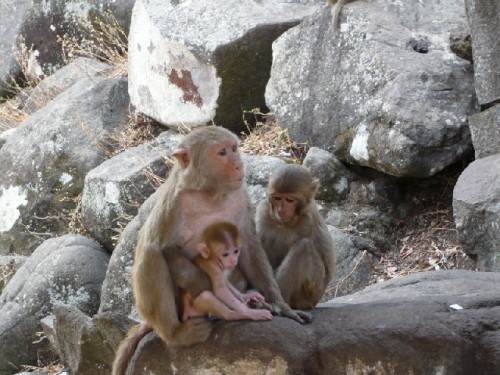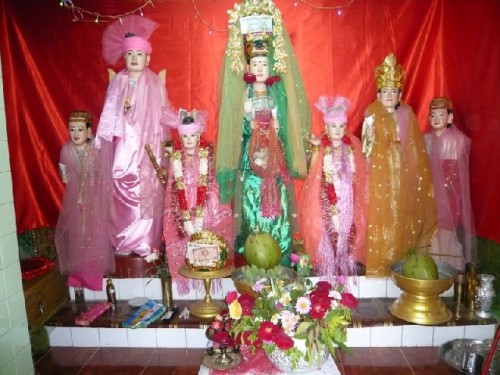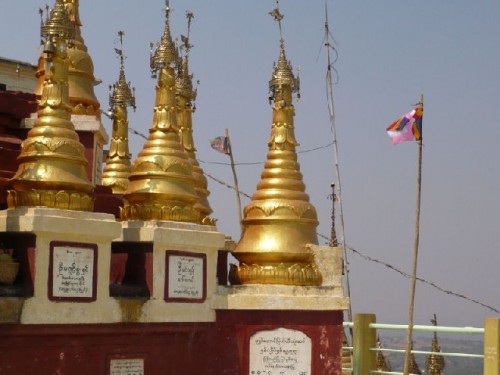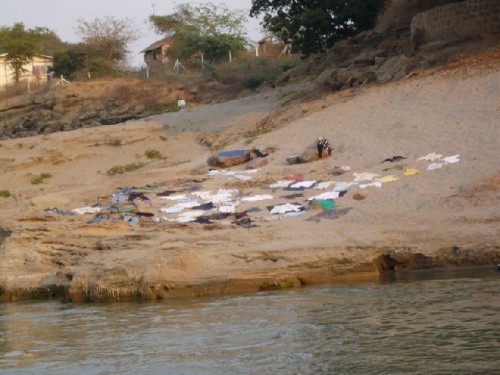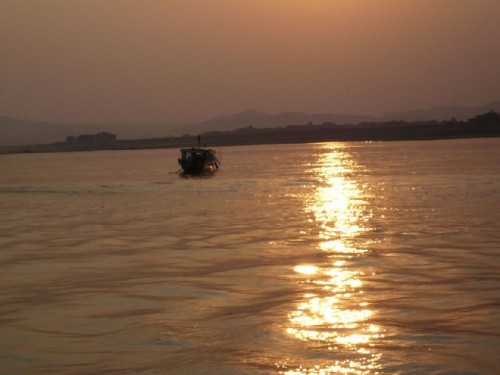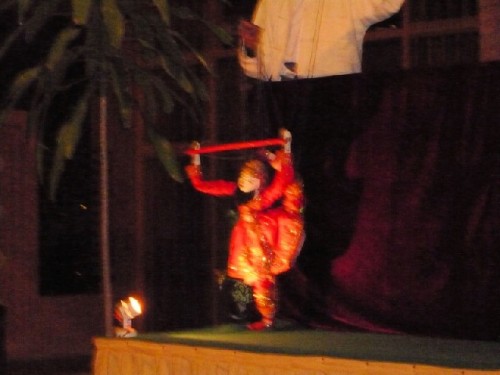Myanmar (Burma)
Part Two: Bagan
By: Zeren Earls - Apr 14, 2010
Founded in 849 on the banks of the Ayarwaddy River, Bagan is located in the central part of Myanmar, which is the largest country on the Southeast Asian peninsula - almost three times the size of Great Britain. As we approached Bagan from the air, its savannah landscape stretching for miles indicated a hot, dry climate. At the airport, a display of umbrellas made of bamboo and hand-painted fabric in floral designs promised a city rich in traditional crafts. Our sightseeing began right after arrival with a walk through local market in the district of Nyaung.
The sprawling street market covered everything from food to clothing to household goods, mostly spread on the ground or on makeshift crates. Earthenware pots, heaps of fresh and cooked food, lacquerware, bamboo art, and stacks of beautiful clothes each sold for a few dollar bills. The country's widespread poverty, with many barely scraping a living from the land, was evident from the vendors' desperate need to sell. I made two very happy by buying a longyi and a bamboo picture frame.
The splendor of the pagodas stands in stark contrast to the visible poverty. The Shwezigon Pagoda is of particular note. The first pagoda to be built in the characteristic Burmese style, it consists of three square terraces with stairways leading up to the bell-shaped main body of the stupa, featuring tapering rings to the top. In addition to this enormous weight in gold, Buddha statues, big and small in surrounding shrines, continually glow as worshippers layer them with gold leaf. Its nat shrine, the first of its kind in a Buddhist pagoda, has thirty-seven nats to venerate in addition to Buddha.
The most impressive masterpiece is the Ananda Temple, built around 1090. At the four corners of its square base are porticos leading to passages into the interior; at the end of each portico is a 33-foot-high glowing statue of Buddha. The four corners of the temple are guarded by lions, which have one head and two bodies. The top of the temple soars to a height of 167 feet and is crowned by a gilded shikhara.
After lunch and a brief rest at our hotel, the Aye Yar Riverview, we went back out to explore more temples in old Bagan, which boasts 4000 temples and pagodas and is a UNESCO heritage site. I wore my new longyi, as covered legs and shoulders with no footwear are the proper attire for visiting sacred sites. The Sulamani Temple stood out with its frescoes of Buddha images and of stories from his life, though many of the frescoes are deteriorating.
The ancient pagodas are spread over a 15-square-mile area; several are situated outside the city walls in order to provide spiritual protection for Bagan. The common modes of transportation to see these are the horse cart and the bicycle. We rode a horse cart to Shwesandow, also known as the Sunset Pagoda, as visitors gather here to take advantage of the fantastic view over the temples and the river. At sunset, the pagoda was hopelessly crowded. I managed to climb up to the second of its four square terraces, which give it a pyramidal form. The view was indeed fantastic. The landscape radiated an almost unearthly beauty in the soft light of evening.
Our day ended with dinner at a riverside restaurant. We enjoyed curried fish and beef with rice, eggplant and salad. Waiters delivering the meal while holding lit torches added to the spectacle of the setting.
Early the next morning was the much anticipated hot air balloon ride I had signed up for in advance. I was picked up at the hotel at 5:45 in an old British army vehicle, which the company Balloons over Bagan has purchased from the government to transport passengers. After tea and cookies and safety instructions, we climbed into the balloon basket - twelve passengers, three per section. The hour-long ride over ancient Bagan and its pagodas at sunrise was spectacular. We hovered over pagodas large and small, seeing their architectural detail in close range, waved to locals cooking breakfast outside of their thatched bamboo houses, and learned about crops - rice, onions, peanuts, sesame - grown at the river's edge. The locals harvest these crops before the river rises with the melting of the snow in the Himalayas. Our British pilot was well-informed and gave us a wealth of information, including an explanation of the controversy between residents and UNESCO, which wants to move their houses back to protect the heritage site. Our adventure ended with a champagne toast upon landing.
At TUN Lacquerware, we learned about Myanmar's finest art form. Lacquer is made from the sap of the thitsi tree, which grows wild in northeastern Myanmar. The sap is collected by making a shallow V-shaped cut in the bark and allowing the liquid to drip into a bowl at the bottom of the incision. Various substances are mixed with the sap to create lacquer of different colors. The base of the lacquerware object is made of bamboo. Thin strips are coiled into circles, each of which is placed inside the previous one at a slightly higher level. Notched edges keep the strips in place. Lacquer mixed with ash fills the spaces between the coils. After receiving several coats and drying in between over a period of three days in a humid cellar to prevent cracking, the piece is polished smooth. Objects with decorations, such as multicolored incised designs and gold leaf patterns, require additional work. The time needed to finish a piece depends on the number of colors used. The pieces range from Buddha images to bowls, vases, boxes, stacked food carriers, cups and trays, all very beautiful.
Mount Popa - "popa" means "flowers" in Sanskrit - is a 4980-foot extinct volcano located 32 miles southeast of Bagan. On the way there we visited a palm sugar farm, where all the trees had bamboo ladders attached to their trunks. Young men climbed trees with earthenware pots tied to their waists, exchanging empty containers for ones filled with palm juice. Women stirred the juice over a fire until thick, then shaping it into small balls of sugar. Nearby an ox drove a stone mill, which ground peanuts to extract oil. Palm leaf handicrafts and a bamboo restroom with a facade woven into intricate patterns were delightful.
To the southwest of Mount Popa is the volcanic peak of Popa Taung Kalat, which is said to be the home of the nat spirits, who protect the mountains, and is therefore one of the most important sites for nat worship in Burma. A covered stairway with 700 steps leads to the Temple of Sacred Spirits, 2554 feet above sea level. Leaving our shoes with an attendant at the bottom of the stairway, we began our climb, accompanied by monkeys begging for bananas, nuts and sweets. Vending stalls flanked the steps, which were crowded with pilgrims carrying offerings of flowers and food. The shrines dazzled the eye with mirrors, neon lights, bright colors, gold leaf and plenty of money to appease the spirits, which can do a great deal of damage if crossed. Once at the peak, we enjoyed a panoramic view of the surrounding mountains, including the imposing monastery on top of Mount Popa.
The sunset river cruise was yet another window onto local life. By the boat dock, children hawked postcards, bracelets, shirts and longyis; some women washed and spread laundry by the river's edge, while others dug up sand in buckets, which they carried to barges on their heads for transport to construction sites. The setting sun silhouetted pagodas at a distance and trees with exposed roots near the shore. Fishing boats grew dark as the river's waters shimmered in the last glow of the sun.
The last thing we did in Bagan was to attend a marionette show. In a society where the natural and supernatural easily overlap, puppets occupy a place between humans and spirits. The puppets represent easily identifiable mythological characters, both animal and human. They use courtly, refined language and share the stage with the puppeteer in full view. The accompanying singers and orchestra are an intrinsic part of the troupe. In the face of modern movie and TV entertainment, this ancient fine art only survives due to the continued interest of foreign visitors. I was one such admirer. After seeing the richly dressed, well-crafted marionettes, I decided to look for one to take home. Jan, our trip leader, suggested I wait till I arrived in Mandalay, as we would be visiting a village famed for its marionette craftsmanship.
Having thoroughly enjoyed my four days in Myanmar, I eagerly looked forward to the next two in Mandalay.

